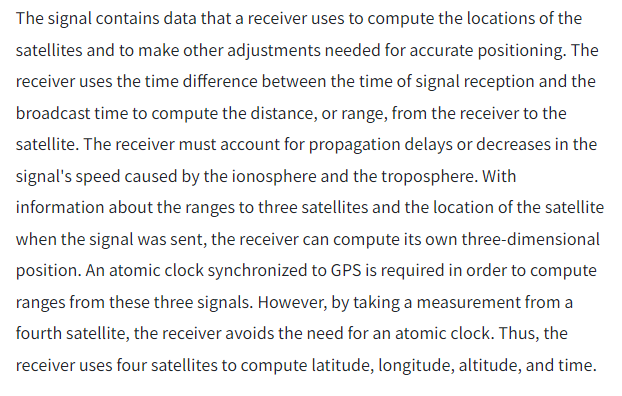Alaskansnowbirds
Site Team
IIRC atomic clocks get their signals from HF radio signals, not satellites.
I see Don and I were typing at the same time.
I see Don and I were typing at the same time.
That's interesting, Dan. Every reference I've found shows that four satellites are needed for altitude, three to get horizontal location. And a presentation a number of years ago by the GPS labs at Colo. Univ. at Boulder showed the same. My experience indicates the same. On receivers where I looked at the number of satellites as the receiver searched, no position was shown until 3 satellites were in view, and it took four to get altitude.
At Finding Latitude and Longitude with GPS - How GPS works they say, "The system needs at least 3 satellite to obtain a latitude and longitude fix. Four satellites allows your height to be determined as well and the more satellites that can be received, this higher the accuracy of the results."
Possibly, I don't really know. The connection icon on the screen looks kinda like a satellite ground station, similar to the radio telescopes south of Bishop.My atomic clock gets its signal from WWV. Has nothing to do with satellites. It's an HF signal from Ft. Collins, Colorado. Could that be what yours is also?
-Don- Reno, MV

It's definitely HF. I have three units like that, two in my basement where satellite couldn't possibly reach, but they work fine. Note that WWVB in the US broadcasts on 60kHz, which is the source for the misleadingly-named "atomic" clock.My atomic clock gets its signal from WWV. Has nothing to do with satellites. It's an HF signal from Ft. Collins, Colorado. Could that be what yours is also?
-Don- Reno, MV
The time signals broadcast by WWVB from Ft Collins, CO originate from the cesium atomic time standard clock maintained by the National Institute of Standards and Technology in Boulder, CO. That clock and a similar one in France are considered the most accurate clocks in the world.It's definitely HF. I have three units like that, two in my basement where satellite couldn't possibly reach, but they work fine. Note that WWVB in the US broadcasts on 60kHz, which is the source for the misleadingly-named "atomic" clock.
That's true, Dutch, and it's extremely accurate, just as the regular WWV broadcasts are very accurate, but the advertising seems (to me at least) to imply that the device you buy is an atomic clock, rather than just being fed by a signal derived from one, even though that's not possible for most of those devices, especially a consumer device.The time signals broadcast by WWVB from Ft Collins, CO originate from the cesium atomic time standard clock maintained by the National Institute of Standards and Technology in Boulder, CO. That clock and a similar one in France are considered the most accurate clocks in the world.
The 4th satellite only provides a reference time so the ground GPS doesn't need a clock - whew...
The tricky part is all the math required to allow for delays in signal based on satellite position vs. the atmosphere the signal has to pass through.
Pretty complex stuff.
View attachment 156710
It's not just cell companies. In the late '80s/early '90s AT&T was redesigning the phone network for many parts (eventually all) to be based on GPS time, critical for syncing many newer parts of the network, and especially so for some of the new stuff that was to come out. Although I wasn't directly involved, one of my peers was heavily involved, so I had occasional updates on the progress. But since I retired in '98 I lost those updates.All of the cell companies use GPS to sync time across their systems. This makes your phone clock accurate. We won't even get into the discussion of leap seconds.
That is correct. All timing used to be slaved from a master clock located in a hardened underground ATT facility in Hillsboro, Missouri. Central standard time was referred to by all entities as "network time".It's not just cell companies. In the late '80s/early '90s AT&T was redesigning the phone network for many parts (eventually all) to be based on GPS time, critical for syncing many newer parts of the network, and especially so for some of the new stuff that was to come out. Although I wasn't directly involved, one of my peers was heavily involved, so I had occasional updates on the progress. But since I retired in '98 I lost those updates.
Take a photo of you clock and post it here.The connection icon on the screen looks kinda like a satellite ground station, similar to the radio telescopes south of Bishop.
